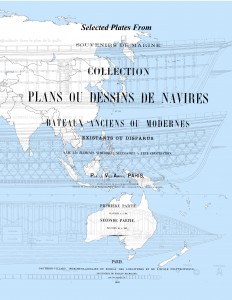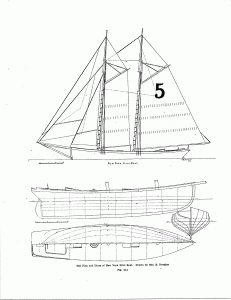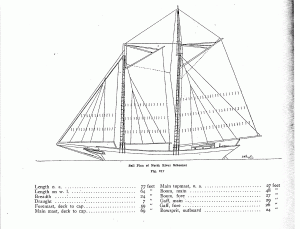There’s not many things more exciting for a maritime history aficionado than digging through a pile of books at an antiques store and finding a nearly 100-year-old shipbuilding book in good condition. When it’s in a pile marked $1, it’s hard not to do a little dance, but I did my best to stifle an Irish jig when I found Wooden Ship-Building by Charles Desmond, Copyright 1919 The Rudder Publishing Company.
Using as an example illustrations from the ill-fated wood steamship project of the Emergency Fleet during World War I, Desmond ties together the art that made clipper ships possible with modern cargo vessels. This alone makes the book an interesting read, but the illustrated ship plans near the end of the book make it a valuable addition to any model shipwright’s library.
One great example is the plan of a New York Pilot Schooner. These boats share a lot in common with the Baltimore Clipper Schooner in hull shape. Especially in the “drag” of the keel: The ship sits much deeper at the stern than at the bow. One way in which they differ from their ancestor is the bow is much more plumb. Baltimore Clippers tended to have the outward curving bow of a cutter. Howard Irving Chapelle later documented this perennial favorite of model ship builders with the plans of the New York Piliot Schooner Phantom in The History of American Sailing Ships.
A less common plan that Desmond includes is a 77-foot North River Schooner, typical of the shoal draft centerboard sailboats used on the Hudson River to haul bulk cargo in the 19th Century. Less sleek and more workman-like than the pilot schooners, these river mules were probably more numerous. They had a shallow, tub-like hull with a centerboard to better deal with the shallow unpredictable waters of a river. When it was extended, the centerboard acted as a keel, giving the boat stability when tacking to windward, keeping it from “crabbing” – moving sideways rather than forward. When retracted, it allowed the boat to get into shallow waters, or even be beached for unloading where a harbor wharf wasn’t available.
Books Available From The Model Shipwright

Souvenirs de Marine by
François-Edmond Pâris

